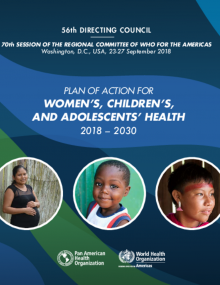Over the past years, our Region has made important progress toward improving the health of women, children, and adolescents. Neonatal, child, and maternal mortality have declined. However, the advancements have not benefitted all population groups equally: major variances exist between and within countries. Consistently, women and children from the lower socioeconomic levels, along with those living in rural settings, indigenous groups, Afro-descendants, and the less educated have higher burdens of morbidity and mortality. Adolescent mortality, mainly due to preventable causes, has remained stagnant or has increased, and adolescent pregnancy remains unacceptably high.
Further progress to improve the health of all women, children, and adolescents in the Americas was made in September 2018, when Member States of the Pan American Health Organization (PAHO) adopted The Plan of Action for Women’s, Children’s and Adolescents’ Health 2018- 2030.
The Plan of Action was developed with the goal of protecting the gains achieved so far and closing the remaining gaps toward ensuring healthy lives and promoting well-being for all women, children, and adolescents in the Americas. While previous regional mandates and work related to the health of women, children, and adolescents were captured in separate plans and resolutions, this Plan proposes an integrated life-course approach to address the common challenges and barriers, to build health and well-being over time and across generations. The Plan aligns with the Sustainable Development Goals, the Global Strategy for Women’s, Children’s and Adolescents’ Health, the Sustainable Health Agenda for the Americas 2018-2030 and resonates with the Declaration of Astana 2018.
|

